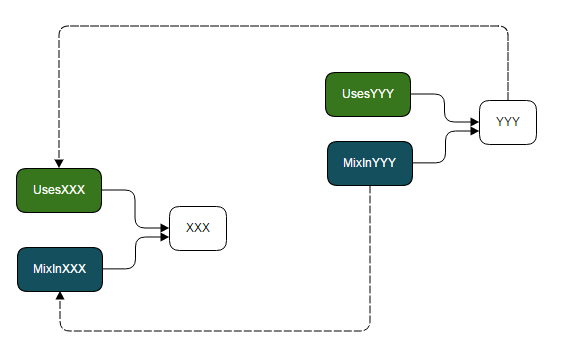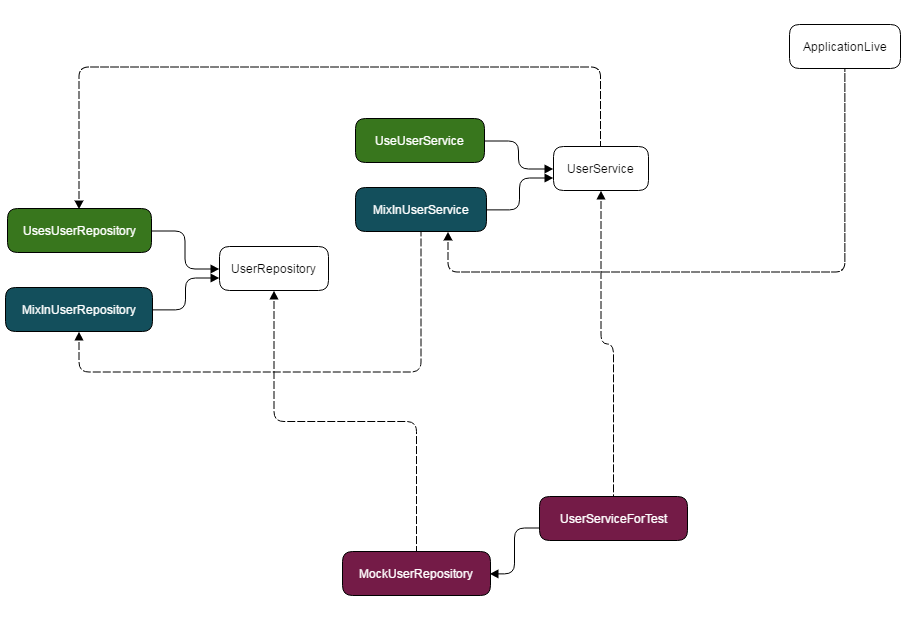orakaro / Pure Swift Dependency Injection
Programming Languages
Labels
Projects that are alternatives of or similar to Pure Swift Dependency Injection
You don't need (Swift) Dependency Injection Framework
There is Cake Design Pattern in Scala to do Dependency Injection (DI), and a minimal version called Minimal Cake Design Pattern.
We don't really need a framework to do DI in Swift. With pure Swift code only, I will introduce you how to use Minimal Cake Design Pattern to do DI at production and test code.
Every class need Interface and Implementation
With every class, I will create an Interface using protocol, which name started withUses..., and an Implementation using class which name started with MixIn....
Interface only declares what the protocol can do, and Implementation declares how.
protocol UserRepository {
func findById(id: Int) -> User?
}
// Interface
protocol UsesUserRepository {
var userRepository: UserRepository { get }
}
// Implementation
class MixInUserRepository: UserRepository {
func findById(id: Int) -> User? {
return User(id: id, name: "orakaro", role: "member")
}
}
When instance of UserRepository is used by another class, for example UserService, I will use above Interface to declare a new pair protocol/extension, and of course another Interface and Implementation for UserService itself.
Sounds more complicated than it is. Let’s look at the code.
protocol UserService: UsesUserRepository {
func promote(asigneeId: Int) -> User?
}
extension UserService {
func promote(asigneeId: Int) -> User? {
guard var asignee = userRepository.findById(id: asigneeId) else {return nil}
asignee.role = "leader"
return asignee
}
}
// Interface
protocol UsesUserService {
var userService: UserService { get }
}
// Implementation
class MixInUserService: UserService {
let userRepository: UserRepository = MixInUserRepository()
}
What if UserService is used by another TeamService again? Well the same logic is applied, UsesUserService is used to declare a pair of protocol/extension, and there will be Interface/Implementation for the new service also.
protocol TeamService: UsesUserService {
func buildTeam(leader: User) -> [User?]
}
extension TeamService {
func buildTeam(leader: User) -> [User?] {
return [userService.promote(asigneeId: leader.id)]
}
}
// Interface
protocol UsesTeamServvice {
var teamService: TeamService { get }
}
// Implementation
class MixInTeamService: TeamService {
let userService: UserService = MixInUserService()
}
All this kind of wiring is statically typed. If we have a dependency declaration missing or something is misspelled then we get a compilation error. Furthermore implementation is immutable (declared as let).
Application use Implementation
For example our application using TeamService can be like this
let applicationLive = MixInTeamService()
let team = applicationLive.buildTeam(leader: User(id: 1, name: "orakaro", role: "member"))
print(team) // [Optional(User(id: 1, name: "orakaro", role: Optional("leader")))]
DI using Interface
At this time we already can inject a mock repository into UserService to test the promote method even without mocking framework.
We are not merely creating mocks but the mocks we create are wired in as the declared dependencies wherever defined.
class MockUserRepository: UserRepository {
func findById(id: Int) -> User? { return nil }
}
class UserServiceForTest: UserService {
let userRepository: UserRepository = MockUserRepository()
}
let testService = UserServiceForTest()
print(testService.promote(asigneeId: 1)) // nil
The same way can be used to inject TeamService to test buildTeam method.
class TeamServiceForTest: TeamService {
let userService: UserService = UserServiceForTest()
}
let applicationTest = TeamServiceForTest()
let testTeam = applicationTest.buildTeam(leader: User(id: 1, name: "orakaro", role: "member"))
print(testTeam) // [nil]
For more detail see playground in this repo.
Summing up
I found this solution to be a simple, clear way to structure Swift code and create the object graph. It uses only pure Swift protocol/extension, does not depend on any frameworks or libraries, and provides compile-time checking that everything is defined properly.


